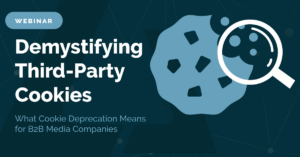Industry groups are predicting that U.S. companies plan to spend 15% more on advertising this year coming out of the pandemic. Based on impressive Q1 numbers from Google, Facebook, and Amazon, digital marketing is taking the majority of ad spend with more people spending increased amounts of time online. However, transitioning from anonymous site traffic to known users remains evermore daunting. These market forces have marketers scrambling to forge direct relationships with users in hopes of being able to manage their journeys in any meaningful way. Meanwhile, users have become more aware of how companies track their online movements. This increases the amount of users who push back on intrusive online experiences that require personally identifiable information (PII) to personalize an experience. As a result, some marketers are experimenting by replacing ham-handed requests for PII with Zero-Party data (ZPD) that ask simple questions that users can easily answer without the risk of compromising their privacy.
So instead of hitting anonymous users with newsletter signups that require submitting an email address, marketers are now asking non-PII questions that still provide data that is useful in personalization and audience segmentation. Think of ZPD as preference data versus behavioral data. It’s optional information that users grant marketers, like clothing size or style preferences, for the purpose of a particular intent or value exchange that does not over-step the privacy line. Here are some low-hurdle ZPD tactics to consider putting in front of anonymous users before rushing to gather PII:
Ask for preferences
Start with the ones your brand can consistently take action on. For example, an airline might request a seat preference (window or aisle) and/or a special meal request (Kosher, vegetarian or gluten free). Similarly, a hotel may ask for an upper or lower floor choice or a pillow preference (feather, down or hypoallergenic). Whatever preferences you ask about, be sure to deliver on those requests regularly.
Don’t overwhelm your users
You don’t want to ask so many questions that they stop answering and never submit their information. Just make a few queries that will provide insights on which you can deliver, and fill in more over time.
Leverage zero-party data for audience segmentation
Early on in a customer relationship, a brand knows very little about an individual. Requesting information upfront can help your brand fit that customer into one of your marketing segments and/or journeys much earlier in the relationship.
Don’t ignore preferences
If a customer tells you she’s in the market for a truck, she doesn’t want to receive emails touting the benefits of the latest sedan. Ensure that your brand communications across all channels (direct mail, email, social media, SMS, etc.), align with a customer’s preferences.
Promotional preferences
While we’d all love to get 100% off coupons, perhaps your brand will discover that certain clients prefer last-minute deals, while others like weekly offers. Still, others may want to hear from your brand only once a month.
Let customers pick favorites
For example, Dunkin’ Donuts and Starbucks provide this functionality. Again, this is a customer-centric and convenient benefit for regulars so attached to your brand that they’ve downloaded your app and actually use it.
Gamify with quizzes
For example, beauty brands often provide helpful insights into customers’ hair and/or skin types (i.e., oily, dry or combination) in exchange for their answers. You can also then provide helpful product recommendations in your brand interactions.
Encourage customers to share their likes
Apple Music and Spotify, for example, ask members to share favorite genres and performers which then can be used to make initial recommendations.
Record customer preferences in a CDP
Just as your products and services change, a customer’s preferences will as well. Maybe a traveler wasn’t interested in far-flung destinations when her kids were young. But now that they’ve flown the coop, they want to travel halfway around the world to check Bali off their bucket list. Ask for preferences periodically, noting that your brand wants to ensure messages are serving them well.
>>> Learn more about Zero-Party Data
















